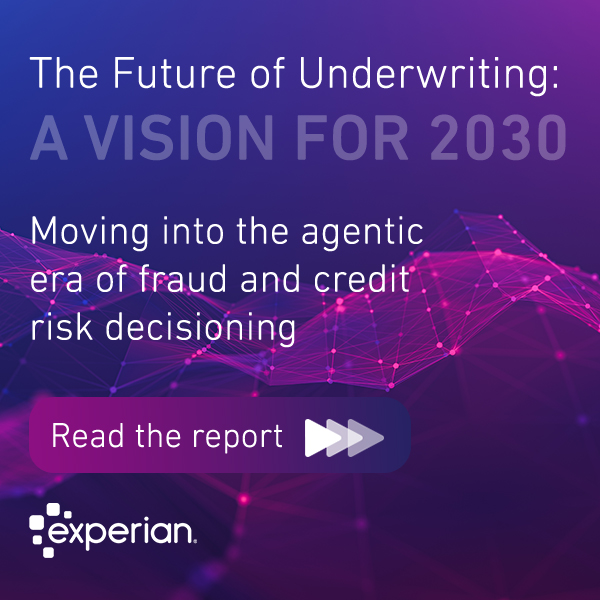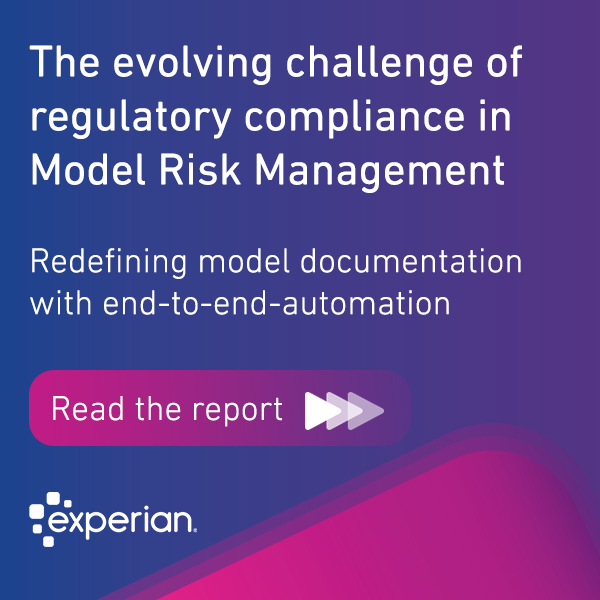Search Results for: DATA AI

As economic uncertainty continues to loom, the threat of fraud continues to grow and is becoming more sophisticated. It’s only going to get worse. Due to intensifying inflationary pressures, prices and costs have been increasing which has led to financial hardship impacting individuals and businesses. This provides an opportunity and motive for bad actors to figure out new ways to commit fraud. Federal Trade Commission data shows that consumers reported losing nearly $8.8 billion to fraud in 2022, an increase of more than 30 percent over the previous year. PwC’s Global Economic Crime and Fraud Survey 2022 shows 51% of surveyed organisations say they experienced fraud in the past two years, the highest level in their 20 years of research. Additional investments in fraud prevention technology are a priority for businesses to combat these evolving threats, according to Experian's Sept. 2022 Global Insights report, which states that 94% of businesses report it as the top priority. Since fraud is becoming more sophisticated, part of the challenge that businesses face is to constantly evaluate multiple solutions so that they can continuously improve their fraud detection and prevention capabilities. Investments that can deliver the highest ROI are the solutions that are integrated and orchestrated in a comprehensive fraud reduction intelligence platform. This gives businesses the flexibility to manage evolving strategies and mitigate threats with real-time decisioning. Experian’s CrossCore is an integrated digital identity and fraud risk platform. It offers global solutions to help protect businesses from fraud and maintain compliance with regulatory requirements, using real-time risk analytics and decision-making strategies. The platform aggregates various fraud and identity verification sources to consolidate risk and trust decisions for Experian clients throughout the consumer journey. Experian’s CrossCore has been recognized as an Overall Leader, Innovation Leader, Product Leader, and Market Leader in KuppingerCole’s Fraud Reduction Intelligence Platform Leadership Compass 2023. This recognition highlights Experian's comprehensive approach to combating fraud. It validates that CrossCore offers best-in-class capabilities by augmenting Experian’s industry-leading identity and fraud offerings with a highly curated ecosystem of partners which enables further optionality for our clients based on their specific needs. Read the report CrossCore's Capabilities

Latest Global Insights Report: How supporting consumers in a time of uncertainty can help businesses adapt and grow A changing economic landscape needs a new approach The new digital consumer is here to stay and they expect businesses to support them with the products and services they need to navigate the rising cost of living, in a secure digital world personalised to them. Find out how: Our latest research reveals how economic uncertainty is evolving the experiences and expectations of digital consumers. From increasing the demand for credit options and financial inclusion, to deepening the need for trust, security and being seen. Read the report to find out how businesses can benefit from responding to changing consumer needs - including the additional tools and resources consumers and businesses may need to maintain financial health: What do digital consumers want? The global economy is under pressure with inflation raising prices across the world. In response, consumer behaviour is shifting, as people tackle the increased cost of living, and the prospect of an economic downturn. Digital consumers are continuing to manage their lives online and are expecting businesses to take the lead on improving the digital environment. A quality online experience is paramount, or consumers will move on. 1 in 4 businesses lost more than 10% of their customers in 2021, due to “suboptimal” digital experiences. A range of payment options including BNPL As prices rise, consumers are expecting to spend more online and are looking for varied credit options to help manage their finances. The demand for buy-now-pay-later (BNPL) options is also growing, with more consumers using BNPL to buy household staples. Consumers look favourably on companies that offer BNPL, but companies will have to find the right balance between supporting customers and managing credit risk. 32% of BNPL purchases were for groceries, up from 27% in March. Financial inclusion Economic uncertainty is accelerating the need for greater financial inclusion. Businesses need to find more creditworthy consumers and support them with responsible and sustainable products and services. 1 in 3 businesses is in the process of rolling out financial inclusion initiatives Security and trust As consumer need increases, so does fraud, including cost of living scams. Security is now a top priority for consumers around the world, alongside privacy, convenience and personalisation. 50% of consumers say they’re concerned about their online transactions. However, trust in emerging customer recognition tools is increasing, with consumers’ top three including physical biometrics, PIN codes and behavioural biometrics. Personalisation Consumers who trust businesses are more willing to share their data, enabling companies to create more personalised experiences, which in turn, improves consumer trust. 46% of consumers say that personalisation (receiving offers that fit their needs) is the most important aspect of their online experience. Read our report to discover the challenges and opportunities facing consumers and businesses and the tools, resources and strategies that can help your company get ahead. The survey results represent 6,000 consumers and 2,000 businesses across 20 countries, including Australia, Brazil, Chile, China, Columbia, Denmark, Germany, India, Indonesia, Ireland, Italy, Malaysia, Netherlands, Norway, Peru, Singapore, South Africa, Spain, UK, and US. Read our report

Latest Global Insights Report: How supporting consumers in a time of uncertainty can help businesses adapt and grow A changing economic landscape needs a new approach The new digital consumer is here to stay and they expect businesses to support them with the products and services they need to navigate the rising cost of living, in a secure digital world personalised to them. Find out how: Our latest research reveals how economic uncertainty is evolving the experiences and expectations of digital consumers. From increasing the demand for credit options and financial inclusion, to deepening the need for trust, security and being seen. Read the report to find out how businesses can benefit from responding to changing consumer needs - including the additional tools and resources consumers and businesses may need to maintain financial health. What do digital consumers want? The global economy is under pressure with inflation raising prices across the world. In response, consumer behaviour is shifting, as people tackle the increased cost of living, and the prospect of an economic downturn. Digital consumers are continuing to manage their lives online and are expecting businesses to take the lead on improving the digital environment. A quality online experience is paramount, or consumers will move on. 1 in 4 businesses lost more than 10% of their customers in 2021, due to “suboptimal” digital experiences. A range of payment options including BNPL As prices rise, consumers are expecting to spend more online and are looking for varied credit options to help manage their finances. The demand for buy-now-pay-later (BNPL) options is also growing, with more consumers using BNPL to buy household staples. Consumers look favorably on companies that offer BNPL, but companies will have to find the right balance between supporting customers and managing credit risk. 32% of BNPL purchases were for groceries, up from 27% in March. Financial inclusion Economic uncertainty is accelerating the need for greater financial inclusion. Businesses need to find more creditworthy consumers and support them with responsible and sustainable products and services. 1 in 3 businesses is in the process of rolling out financial inclusion initiatives Security and trust As consumer need increases, so does fraud, including cost of living scams. Security is now a top priority for consumers around the world, alongside privacy, convenience and personalisation. 50% of consumers say they’re concerned about their online transactions. However, trust in emerging customer recognition tools is increasing, with consumers’ top three including physical biometrics, PIN codes and behavioural biometrics. Personalisation Consumers who trust businesses are more willing to share their data, enabling companies to create more personalised experiences, which in turn, improves consumer trust. 46% of consumers say that personalisation (receiving offers that fit their needs) is the most important aspect of their online experience. Read our report to discover the challenges and opportunities facing consumers and businesses and the tools, resources and strategies that can help your company get ahead. The survey results represent 6,000 consumers and 2,000 businesses across 20 countries, including Australia, Brazil, Chile, China, Columbia, Denmark, Germany, India, Indonesia, Ireland, Italy, Malaysia, Netherlands, Norway, Peru, Singapore, South Africa, Spain, UK, and US. Download Report

Our latest Global Identity and Fraud Report reveals that fraud has been of high concern for consumers over the past year. In fact, more than half of consumers report that they are worried about online transactions, and 40% say that their concern has increased over this period. Data breaches, well-publicised scams, and direct first-hand experience with fraud have all contributed to these higher levels of concern. Our study shows that 77% of consumers had increased concern after experiencing online fraud, with more than half of consumers surveyed having had a close encounter with fraud: 58% of consumers say they have been a victim of online fraud, know someone who has been a victim, or both 57% of consumers say they have been a victim of identity theft, know someone who has been a victim, or both 53% of consumers say they have been a victim of account takeover, know someone who has been a victim, or both As a consequence, it makes sense that consumers rank security and privacy above convenience and personalisation when evaluating their online experience and expect businesses to take the necessary security steps to protect them online. We look at the main factors that play a role in the high levels of fraud concern among consumers and what businesses should do to address challenges in their fraud strategies. Three contributing factors to increased fraud concern among consumers Identity fraud has increased Our research also unveils that identity theft has overtaken credit card theft as consumers’ biggest security worry across all age groups. Furthermore, a recent report from the UK showed that recorded cases of identity fraud have grown by 22% over the past year. Fraud prevention and security professionals have been trying to educate consumers for a long time on this topic. Stealing identity data and using it in multiple fraud schemes can be significantly more harmful than criminals having access to someone's credit card numbers, where transactions can be traced quickly and revoked or charged back. While many factors contributed to an increase in concern about identity theft, the most impactful over the past two years were the numerous cases of unemployment and benefits fraud. Multiple countries reported cases where criminals applied for loans in the name of genuine consumers or through synthetic identities, created by combining real stolen information with fake data. The cost of these scams is yet to be discovered, and it could take years to see their full effect, with fraud losses well into the billions (if not trillions) of dollars worldwide. Criminals can access stolen data and fraud tutorials beyond the dark web To commit many types of fraud, criminals need Personal Identifiable Information (PII) that is stolen through techniques such as hacking attacks, credential harvesting, credential stuffing, phishing, or other types of social engineering. For years the knowledge of how to do that, along with the stolen data available after a successful attack, was available mainly on cybercriminal forums accessed through the dark web. However, over the past year, it has become easier than ever to obtain not only PII data but also valuable information on how to bypass some of the security and fraud features in place for a certain institution. Criminals no longer need to go to the dark web to do that - it's available on platforms like Telegram, just a few clicks away, where other fraudsters are selling tutorials (often called 'Sauce') on how to commit fraud, as well as PII data (called 'Fullz') to achieve it. As a result, the entry level for those that want to commit fraud has been set lower than ever before - both in terms of skillset and accessibility. Phishing and scams are at all-time high Another contributing factor to the increase in consumer concern is the number of scams resulting in authorised push payment fraud, which totalled £583.2 million in the UK alone during 2021. Criminals continue to seek out consumer vulnerabilities and use a variety of tactics to apply pressure on their victims and convince them to transfer money out of their bank accounts. This could take many forms - from various types of impersonation scams, romance scams, and investment (fraud) opportunities, to scams related to utility bills and easy loan offers among other types. This wouldn't be possible without numerous phishing/smishing/vishing attempts and the amount of data available through data breaches. One other factor that helps criminals is the direct access to potential victims given by social media and the sheer volume of personal information available in the public domain. These types of scams sometimes get high publicity (and rightly so) which can also contribute to the increased level of concern among the public while also applying additional pressure on financial institutions to improve their fraud screening and transaction monitoring capabilities to protect consumers. How businesses can improve fraud screening capabilities and increase consumer trust To restore consumer trust, businesses need to look for ways to improve their capabilities both at account opening and login to prevent criminals from gaining easy access to their services. There are multiple ways to do that, from introducing online identity document verification or phone-centric identity verification capabilities at the account opening stage, to adding behavioural biometrics, device intelligence, or fraud data sharing capabilities during different stages of the customer journey. By introducing some of these capabilities businesses also can improve the digital customer journey for genuine consumers and increase trust. Online identity document verification and phone-centric identity verification solutions both offer pre-fill capabilities. These tools can streamline registration processes and thus contribute greatly to a positive consumer outlook of the company that offers them. While behavioural biometrics, device intelligence, and fraud data sharing tools are invisible to both fraudsters and genuine consumers creating a more frictionless experience. Businesses should look carefully at the fraud they are experiencing along with fraud trends shared by similar businesses. This should help inform whether to introduce new capabilities as part of the existing strategy. It's common that companies might need a mix of capabilities to mitigate fraud issues, with additional support from machine learning models to blend them into one cohesive output while limiting the number of false positives and building consumer trust. Stay in the know with our latest research and insights:

It's hard to imagine an individual customer volunteering to remember multiple online passwords for various online accounts. Yet, for most of internet history, passwords have served as the backbone of online security and recognition—and given fraudsters easier access to our personal and financial data. Fortunately, our recent report reveals that consumers and businesses are evolving how they think about online recognition and authentication. Passwords are no longer consumers' preferred method of online security. For the second year, they didn't even make the top three list of what consumers consider the safest recognition methods. Instead, consumers are increasingly open to a variety of recognition tools, from physical and behavioral biometrics to one-time passcodes. By providing recognition choices, companies can improve the customer experience, decrease fraud, and ultimately build even more brand trust. Consumers are moving beyond passwords, but what should come next? Around the world, consumer fraud concern is rising in tandem with fraud activity. More than half of consumers report that they're worried about fraudulent online transactions, and 40% say that their concern has grown over the past year. That's likely because online fraud has become a far too common experience. For instance, 58% of consumers say that they've been a victim of fraud or know someone who has been a victim, and 83% of consumers say online security is their top priority. The awareness has made consumers more interested—and more confident in—emerging online recognition tools. It seems that many are not only tired of passwords but also understand how easily passwords can be compromised. Those surveyed ranked physical biometrics, pin codes delivered to a mobile device, and behavioral biometrics as the safest recognition methods. Notably, consumer confidence in each of the top three methods has increased significantly since 2021. This confidence in advanced recognition tools spans generations. For instance, 90% of Baby Boomers rank physical biometrics as the most secure, and 82% of Gen Xers and 75% of Gen Z say the same. Meanwhile, 81% of Millennials say behavioral biometrics are the most secure. These survey results suggest that most consumers are aware of fraud risk and willing to explore technologies that make their online transactions safer. Why recognition choice leads to better business outcomes Amidst this environment of change, financial service companies have the opportunity to introduce advanced recognition methods. Consumers are showing their willingness to move beyond passwords. But which recognition method should financial service companies choose? Which one will win out over the others? There's no one right answer. Consumers rank physical biometrics, pin codes, and behavioral biometrics as their top three preferences; however, there is no runaway leader in the group. Which method consumers prefer depends on what they're prioritizing. For instance, consumers who want convenience prefer physical biometrics, while people who value security tend to like two-factor authentication. The ambiguity around preferences allows businesses to introduce choice to their customers. Companies can offer visible methods that give customers access to the newer recognition tools they're beginning to prefer. Meanwhile, continuing to layer invisible methods that strengthen the overall security profile and enhance the customer experience. A menu of recognition options speaks to customer sentiments toward emerging technologies and may engender more trust and loyalty to a brand. For example, our 2022 research shows that 59% of consumers say that use of artificial intelligence increases their trust in a company. The key is being transparent about the choiceson offer and the role they play in protecting customer accounts and data. For example, explaining that the data underpinning specific authentication methods never leaves the device can go a long way with customers who may have misguided assumptions or reservations about specific recognition tools. The orchestration imperative Implementing choice can help customers improve the perception—and reality—of their online security. But leveraging multiple recognition options can also help organizations to better fight fraud. Multiple options enhance understanding of the customer and enables data analysis that can more easily identify outliers. The numerous data points strengthen recognition efforts, which further reinforces trust. It's a virtuous cycle that improves the customer experience and benefits the business. However, implementing multiple recognition methods can be a costly endeavor. Whether using outside vendors or developing and maintaining tools in-house, businesses should be layering recognition tools in the most efficient (and affordable) way. This is where orchestration tools really help. Creating secure environments for customers and businesses will continue to be complicated. Fraudsters are only getting more creative, and mitigating their impact requires a complex web of solutions that stymies them at various points. By starting with an orchestration engine, businesses can launch and manage multiple recognition methods more elegantly, using each tool correctly and at the right point in the customer journey. This strategic approach creates a single point of access to fraud and identity solutions, giving a 360-degree view of customer identity and reducing friction across the customer lifecycle. The days of passwords as the primary recognition tool are waning. Today's consumers understand the benefit of advanced recognition methods and will use them to increase their security, convenience and privacy. Offer customers choices, and businesses can meet these evolving expectations and decrease fraud risk along the way. Stay in the know with our latest research and insights:

Online fraud has increased at unprecedented levels over the past two and half years, with numerous reports coming from all corners of the world to confirm that. From benefits and unemployment fraud to authorised push payment fraud, and more advanced scams such as synthetic identity fraud and deepfake fraud, cybercrime has been on the rise. Understandably, the increase in criminal activity has had a significant impact on financial services businesses, and it is little wonder that this has been reflected in our recent study: • 48% of businesses reported that fraud is a high concern, and 90% reported fraud as a mid-to-high concern • 70% of businesses said their concern about fraud has increased since last year • 80% of businesses said that fraud is often or always discussed within their organisations High levels of fraud have also raised consumer concern, and their expectations of the protection businesses should offer them. Nearly three-quarters of consumers said that they expect businesses to take the necessary security steps to protect them online. However, only 23% of respondents were very confident that companies were taking steps to secure them online. Businesses need to take additional steps to meet consumer demand, while also protecting their reputation and revenue streams. Businesses are investing in fraud prevention, so why isn’t it working? As a result of the rise in fraud during the pandemic, there has been an increase in spending related to fraud prevention tools and technology, with 89% of businesses surveyed in our latest research indicating that investment in fraud detection software is important to them. However, there is a risk that institutions could take a siloed approach, and funds could be spent on point solutions that solve one or two problems without adding the needed flexibility to fight multiple attack patterns. This gives fraudsters the opportunity to exploit these gaps. Orchestration and automation drive fraudsters away Criminals constantly evolve. They are not new to technology and have multiple attack patterns that they can rely on. They also share information between themselves at a higher rate and pace when compared with financial institutions, banks, and merchants. Fraudsters can learn how to bypass one or two features in an organisation’s fraud prevention strategy if they recognise weak spots or a vulnerability that they can take advantage of. However, when multiple fraud prevention tools and capabilities work harmoniously against them, the chances are higher that they will eventually be blocked or forced to move to a weaker place where they can exploit another system. Synchronizing multiple solutions together is the key to excellent fraud orchestration Fraud orchestration platforms give businesses the chance to layer multiple solutions together. However, taking a layered approach is not only about piling multiple point solutions but also about synchronizing them to achieve the best output possible. Every solution looks at different signals and has its own way of scoring the events, which is why they need to be governed into a workflow to achieve the desired results. This means that institutions can control and optimize the order in which various solutions or capabilities are called, as the output of one solution could result in a different check for a subsequent one or even the need to trigger another solution altogether. It also gives companies the ability to preserve their user journeys while answering different risks presented to them. Some businesses are seeking to build trust with customers but want to stay invisible to remove friction from their digital customer experience. This is where capabilities such as device intelligence, behavioural biometrics, or fraud data sharing could be added as an additional layer in the fraud prevention strategy. Those additional solutions may only be called 30 per cent of the time when there is a real need for an additional check. Excellent orchestration means that organisations can rely on multiple solutions while only calling the services they need, exactly when they need them. Building trust through a secure but convenient customer experience. Machine Learning should be the final layer to rule them all The results from our research revealed the top initiatives that businesses are leveraging to improve the digital customer journey with the top two being: • Improving customer decisioning with AI • New AI models to improve decisioning While our April 2022 Global Insight Report showed that consumers are becoming more comfortable with AI, with 59% saying they trust organisations that use AI. Fraud orchestration platforms allow companies to deploy unified decisioning by leveraging machine learning (ML) on top of multiple fraud prevention tools. This means they can rely on one cohesive output instead of looking at separate, sometimes contradictory results across various platforms and making subjective decisions. ML can also offer explainability by pointing out the attributes that contributed the most to a particular suggestion or decision. These could be attributes coming from a few different tools instead of one. This also means that operational teams, like fraud investigators, have a single view of activity, resulting in operational efficiency - removing the need to log in to different tools and look at multiple screens, views, and scores, while also enabling faster decisions. Stay in the know with our latest research and insights:

Did you miss these June business headlines? We’ve compiled the top global news stories that you need to stay in-the-know on the latest hot topics and insights from our experts. Protecting customer accounts: The defining domain of digital CISOs CIO reports on data from Experian's latest Global ID & Fraud Report to look at why expanding challenges and responsibilities around customer and employee data protection and user experience means that the right authentication solution is critical. Experian says 25% of consumers were victims of online fraud in Asia Pacific Fintech News looks at Experian's latest Global ID & Fraud Report, citing that a quarter of consumers across Asia Pacific (APAC) have been victims of online fraud, but across all markets surveyed in the region, many remain unconcerned about fraud and identity theft amidst today’s growing fraud risk due to digitisation. Experian India launches PowerCurve Strategy Management, cloud-based decisioning solution The Business Information Industry Association reports that Experian India has launched a new PowerCurve Strategy Management solution, a powerful decisioning solution delivered as software-as-a-service via cloud. Digital wallets win over Brazilian consumers; Interview with Caio Rocha, gives Serasa expert opinion Serasa's Caio Rocha talks to Jovem Pan News in an exclusive interview discussing Experian's recent Global ID & Fraud Report, highlighting that 9 out of 10 Brazilians consider digital wallets safe. Stay in the know with our latest research and insights:

Experian’s latest research shows that the crisis of the past few years has yielded a new, savvier digital consumer. With the rapid move to online services amidst the pandemic, consumers worldwide adapted—and quickly. Fifty-three per cent of consumers say they have increased their online spending and transactions within the past three months, and 50% plan to increase it even more over the next few months. As online activity has surged, so too have consumer expectations for friction-free, secure transactions. More than 80% of consumers say a positive online experience makes them think more highly of the brand. And if businesses don't meet those expectations? Well, switching providers is only becoming easier . For financial service providers, the evolution of consumer behaviour presents both an opportunity and a challenge. It's never been more critical to ensure that digital experiences are convenient and frictionless. However, soon that will be the expectation and not the draw for new customers. Instead, finding unique ways to compete will be what separates the good from the great. Convenience versus risk In our latest survey, consumers ranked security, convenience, and ease of recognition as the top contributors to a positive online experience. All of these are vital components to providing a frictionless transaction. However, seamlessly logging in to a financial app, applying for credit, or managing a balance isn't yet the standard for every provider. Many traditional banks continue to play catch-up with digital upstarts, but consumers are becoming less tolerant of barriers to accessing services and products, with 23% saying that businesses aren’t meeting their expectations for digital experiences. This provides businesses with the opportunity to attract and retain new customers, especially those tired of manual account onboarding processes. For instance, leveraging emerging recognition tools adds to the convenience factor, limiting the time customers spend inputting data and streamlining the entire experience. But even as they continue to prioritise frictionless processes, businesses should be wary of sacrificing security or increasing their own risk. In our survey, 73% of consumers said that the onus is on businesses to protect them online. While they don't want security efforts that slow down their transactions, they expect the level of security to remain high nonetheless. On the business side, we've also seen providers creating friction-free options for lending—for example, in the Buy Now, Pay Later (BNPL) space—that enable consumers to access credit nearly immediately. But even with the convenience, there is still a need to manage affordability and ensure that these customers aren't introducing additional risk to credit models. Differentiate to retain customers: The growing role of rewards With all the innovation underway, a friction-free experience will become the standard. And it may already be so among digital-first businesses. This begs the question: If a secure, convenient experience is the norm for consumers, then how can businesses differentiate themselves? The next competitive differentiator will be how businesses reward customers for their loyalty. It's no longer enough to provide new customers with low-interest or no-interest credit on small purchases. Forward-looking financial services providers are getting far more creative with their rewards. For instance, businesses offering BNPL are enabling their customers to accumulate loyalty points for using the service with multiple retailers. Customers can then put those points to use as discounts on merchandise from the places they already love to shop. Data sharing and analytics play a significant role in this approach, allowing businesses to understand their customers' behaviours and personalise offers and rewards. Notably, our survey reveals that 83% of consumers say their awareness of how companies use their personal data for security, convenience, and personalisation has increased. Today's consumers are as digital as ever, and there's no going back. While friction-free may have been the differentiator before, it's rapidly becoming the standard. Going forward, financial services providers will need to find a new way to compete for savvy consumers who expect—and demand—secure, frictionless online experiences. Stay in the know with our latest research and insights:

Juniper Research’s latest digital identity leader board predicts a big shift in the market – identity and fraud are now becoming synonymous. Experian’s position as number one vendor on Juniper Research’s leader board demonstrates why Experian’s flagship digital identity and fraud platform, Crosscore, is central to the future of identity and fraud management. “We’re thrilled Juniper has positioned us as the top provider of digital identity,” said David Britton, Vice President of Global Strategy for Digital Identity & Fraud at Experian. “Being able to accurately identify a customer in a digital transaction helps our clients provide a better customer experience and prevent fraud. Fighting fraud and reducing risk, while enabling great consumer experience is at the heart of Experian’s mission to make the digital world a safer place, even as cybersecurity rises as a worldwide threat.” Digital identity’s convergence of identity verification and fraud detection presents both opportunities and challenges for businesses, all in direct response to new consumer demands for a seamless, safe and uninterrupted digital customer journey. Key digital identity market Takeaways – Juniper Research Identity and Fraud Are Becoming Synonymous Trust is not a transactional feature of a digital identity system between identity creators and identity subjects, but rather, it is an inbuilt part. Given the unprecedented impact of the COVID-19 pandemic on eCommerce volumes, the advent of remote/hybrid working and the demand for eGovernment services, digital identity’s tie with privacy and security has become much more visible. An ever-increasing number of fraudulent activities highlights the need to ensure customer security and protection of personal and businesses data for integrity of digital identity systems. Fraud and digital identities are closely intertwined, also because preventing fraud involves getting the right identity datapoints, understanding their significance and acting upon the related findings. Governments Will Ramp Up Their Digital Identity Efforts Government regulations and initiatives around digital identity are a vital force shaping the market landscape. Success of eGovernment services is largely dependent on a mechanism of identifying citizens/users in an assured manner, usually via striving to create trusted identities. Even prior to COVID-19, governments around the globe were employing digital identity-related initiatives in areas other than eGovernment services, such as border controls and telehealth. Compelled by the challenges faced in terms of cybersecurity and citizen trust in identity initiatives, governments will increasingly collaborate with third-party vendors to come up with solutions with better usability and security. Identity Verification Use Cases and Underlying Technologies Will Continue to Dominate the Market Verification is one of the key areas affecting the digital identity market, mostly owing to the catalyst power of the pandemic digitalising transactions across all industries and business verticals. The solutions and use cases of digital identity verification (ie, login, anti-fraud, and decentralised identity) are numerous, as secure and convenient customer onboarding has been at the forefront of any critical digital engagement. These use cases and underlying technologies, such as biometrics, lend themselves to different industries and verticals and so, they will continue to enjoy customer uptake for the foreseeable future. Read now: Juniper Research Digital Identity Competitor Leaderboard Related content: Defining digital identity on the back of the ‘big digital shift’ What is digital identity and why should we care? Stay in the know with our latest research and insights:

During the week of International Womens' Day, we shine a spotlight on the women thought leaders across Global Decision Analytics. In this Juniper Research interview, Kathleen Maley, VP of Analytics Product Management talks about the current state of data analytics, with the backdrop of Juniper Research's Future of Digital Awards and its recognition of AIS. Watch the video to discover: Current problems with data analytics Broad nature of activities of what is now defined as analytics Model development, model scoring, model regulatory control, model risk management and model deployment Where is data coming from - is it clean and do we understand it? Importance of humans in the development of algorithms Lack of data - where do we need to close gaps? How does looking at the past help with looking to the future - the importance of current/real-time data The expense of maintenance - tech stack - there are now alternatives Democratization of data - expanding credit access by using non-traditional sources of data Talent shortage of data scientists - low-code and no-code Extracting data value for businesses when data is ever-expanding Stay in the know with our latest research and insights:

The pandemic may have accelerated digital transformation across the world of financial services , but behind the scenes, banks and lenders still face a significant tech debt, and many organizations are committed to continuing the innovation. That's for good reason. Today's consumers increasingly expect a digital-first customer experience. The days of visiting a local bank branch to access financial services and products are fading away. Fintechs have risen to the occasion, transforming the market and meeting the growing digital demand. For traditional banks and lenders, waiting to innovate is no longer an option—it's a must to remain competitive. So what comes next? Here's a look at the technology trends that stand to impact and transform financial services as we advance. 1. The rapid rise of low-code/no-code solutions According to a recent survey from TechRepublic1, nearly half of companies are already using low-code/no-code solutions (LCNC). The same report also notes that among companies not using LCNC solutions, one in five plans to begin within the year. The driving force behind this trend is the global shortage of digital skills, from software development to data analytics to information security. The pool of technical talent has long been smaller than the demand, and the Great Resignation has only exacerbated the problem. For instance, 75% of software developers2 report they're currently looking for other jobs. Amidst this ongoing talent shortage, there's another stressor—the need to deploy technology products to market faster and faster. LCNC solutions answer these challenges by making doing so easier and quicker. The technology democratizes software development, allowing business users—or citizen developers—in different functions to design and deploy applications. With the skills gap likely to continue, the interest in LCNC solutions will too. LCNC solutions enable financial institutions to keep pace with technology changes and meet the digital demand, even with limited technical resources. 2. Leveraging data will require adding value—and engendering trust Financial service organizations have used advanced data analytics to provide consumers with more personalized products. And consumers have been on board as long as they see the benefit. For example, a 2021 consumer survey by Experian showed that 42% of consumers would share personal data, and 56% would share contact information, if it improves their experience. However, this research speaks to growing tension between consumers and financial service providers. The first want more personalized services, but they are also more selective about which companies they share data with. Consider a recent McKinsey study that revealed that 44% of consumers don't fully trust digital services3. As we advance, organizations that want to build and keep consumer trust will need to be thoughtful about the data they ask for and increasingly transparent about how they plan to use it. 3. Doubling down on AI but looking for ROI in the process AI has proven helpful in multiple ways, from powering recommendation engines and chatbots within the retail world to improving fraud analysis and prevention in the banking industry. But there's still so much more organizations can do, especially with the AI they already have. Financial service and fintech companies have funneled massive resources into AI solutions. However, only 20% of AI models4 are ever used in widespread deployment. What’s more, the current average return on AI investments hovers around 1%. This year, expect to see more organizations examining the ROI of AI-powered technology and looking to get more from the investments they've made. Technology partners can help by identifying additional opportunities for AI models to drive customer engagement, validate credit scoring, and protect businesses against fraud. 4. Banking-as-a-Service will yield even more choices and more competition There have long been high barriers that protect traditional financial service organizations from much new competition. But the advent of open APIs and Banking-as-a-Service (BaaS) is knocking these barriers down, yielding a considerable influx of startups that provide banking-like services. And this wave of new fintech has captured consumer interest. Consumers have shown that they’re willing to try financial service products from an array of providers; they're not married to sticking with traditional banks. In fact, 27% of global consumers5 have relationships with neobanks, and 40% report using financial apps6 outside of their primary banking app. However, the gold rush towards BaaS will yield a few winners and a lot of losers. The question for the near-term is who will survive in this crowded market. Consumers will also begin to figure out what makes sense in terms of how many financial organizations they want to connect with and when to say enough is enough. 5. Embedded finance is the new black in retail In a similar theme, the influx of embedded finance products into retail experiences continues to gain traction. There's only more to come. Multiple leading retailers, both longstanding and new D2C brands, have incorporated Buy Now Pay Later (BNPL) payment options into their checkout process, and shoppers are rapidly adopting these new payment methods. One-third of consumers report they've used BNPL before7. Though the payment method still lags far behind other forms of credit, awareness of BNPL and other embedded finance solutions is rising, especially among younger consumers. Looking forward, expect to see embedded finance make inroads not only with more retailers but also across other industries such as hospitality or entertainment. These pressing tech trends are reshaping financial services. In the process, they're bringing new solutions to consumers and new opportunities to banks and non-traditional lenders. Organizations that keep pace with these trends will lay the foundation for their next generation of customers as well as the future of their business. More 2022 trends and predictions Stay in the know with our latest research and insights: 1.TechRepublic Survey: Low-code and no-code platform usage increases 2.Stack Overflow: The Great Resignation is here. What does that mean for developers? 3.McKinsey: Are you losing your digital customers? 4.ESI ThoughtLab: Driving ROI through AI 5.EY: How can banks transform for a new generation of customers? 6.Axway: Consumers are starting to sense an open banking transformation 7.PYMNTS.com: No slowdown in sight for surging BNPL as consumers want it, retailers need it

Steve Wagner, Managing Director, Global Decision Analytics on Redesigning the future of consumer lending with data and analytics. Find Steve Wagner's interview in Raconteur's Future of data report to discover what businesses need to do to succeed in an increasingly digital world. “The good thing is that technology and data now allow businesses to put the customer journey at the heart of what they’re doing. With the advanced technologies available today, businesses can access relevant data and deliver on customer expectations in their moment of need. Whether it’s access to a loan or mortgage, or to consolidate debts, a real-time view of the consumer is possible.” Read the full article and find out about: Why the digital customer experience, enabled by both data and analytics, is the new battleground for many industries. Consumers reporting they were online 25% more in 2021 compared to a year before. Online retail sales saw four years of growth in just 12 months during the Covid pandemic. Demand for frictionless journeys through biometrics or multimodal authentication mean customers can see the value exchange in sharing personal data. Behavioural biometrics is the next frontier in tackling fraud and providing a seamless customer journey. Technology is allowing us to analyse far more data sources in real time, providing a comprehensive picture of an individual. Open Banking and the democratisation of data are part of the progressive change around data. Importance of extracting the insight lenders and fintech providers need to implement the best customer journey and make the best decisions. Businesses can make credit-risk decisions using automation and advanced analytics. This will lead to more opportunities for credit and better financial inclusion. Harnessing the power of 'insight everywhere' for better knowledge bases. "The application of advanced analytics, artificial intelligence and machine learning is allowing businesses to tailor their services to an audience of one - at scale." Stay in the know with our latest research and insights:




